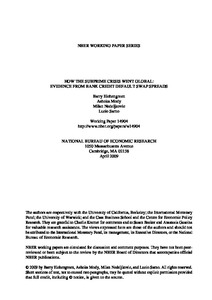How the subprime crisis went global: evidence from bank credit default swap spreads
"How did the Subprime Crisis, a problem in a small corner of U.S. financial markets, affect the entire global banking system? To shed light on this question we use principal components analysis to identify common factors in the movement of banks' credit default swap spreads. We find that f...
| Main Authors: | , , , , |
|---|---|
| Institution: | ETUI-European Trade Union Institute |
| Format: | TEXT |
| Language: | English |
| Published: |
Cambridge, MA
2009
NBER |
| Subjects: | |
| Online Access: | https://www.labourline.org/KENTIKA-19188469124919066419-How-the-subprime-crisis-went-g.htm |
| _version_ | 1771659898057129987 |
|---|---|
| author | National Bureau of Economic Research, Cambridge Eichengreen, Barry Mody, Ashoka Nedeljkovic, Milan Sarno, Lucio |
| author_facet | National Bureau of Economic Research, Cambridge Eichengreen, Barry Mody, Ashoka Nedeljkovic, Milan Sarno, Lucio |
| collection | Library items |
| description | "How did the Subprime Crisis, a problem in a small corner of U.S. financial markets, affect the entire global banking system? To shed light on this question we use principal components analysis to identify common factors in the movement of banks' credit default swap spreads. We find that fortunes of international banks rise and fall together even in normal times along with short-term global economic prospects. But the importance of common factors rose steadily to exceptional levels from the outbreak of the Subprime Crisis to past the rescue of Bear Stearns, reflecting a diffuse sense that funding and credit risk was increasing. Following the failure of Lehman Brothers, the interdependencies briefly increased to a new high, before they fell back to the pre-Lehman elevated levels – but now they more clearly reflected heightened funding and counterparty risk. After Lehman's failure, the prospect of global recession became imminent, auguring the further deterioration of banks' loan portfolios. At this point the entire global financial system had become infected." |
| format | TEXT |
| geographic | USA |
| id | 19188469124919066419_b1a9e13747a84a04a253d6641644652a |
| institution | ETUI-European Trade Union Institute |
| is_hierarchy_id | 19188469124919066419_b1a9e13747a84a04a253d6641644652a |
| is_hierarchy_title | How the subprime crisis went global: evidence from bank credit default swap spreads |
| language | English |
| physical | 35 p. Digital |
| publishDate | 2009 |
| publisher | Cambridge, MA NBER |
| spellingShingle | National Bureau of Economic Research, Cambridge Eichengreen, Barry Mody, Ashoka Nedeljkovic, Milan Sarno, Lucio banking credit economic recession financial market globalization international statistics How the subprime crisis went global: evidence from bank credit default swap spreads |
| thumbnail | https://www.labourline.org/Image_prev.jpg?Archive=116592493477 |
| title | How the subprime crisis went global: evidence from bank credit default swap spreads |
| topic | banking credit economic recession financial market globalization international statistics |
| url | https://www.labourline.org/KENTIKA-19188469124919066419-How-the-subprime-crisis-went-g.htm |

